Book 2. Tver State United Museum. Tver Regional Studies Museum (Lost items - 1228 )
Identifying the cultural property lost during World War II at the Tver State United Museum: results and prospects
During the Second World War military action had been taking place on the territory of modern Tver (former Kalinin) region as the battlefront line had been crossing it from July 1941 to April 1943 with some areas fully or partially invaded, namely the center of the region with the cities Kalinin (2 months), Staritsa (2.5 months), Toropets (5 months), Rzhev and Bely (17 months) with Ostashkov and Likhoslavl having had been the cities near the battlefront. Military actions and the invasion have caused enormous damage to the area’s economy, organizations and institutions, including the museums of the Kalinin region.
In the records of the Emergency State Commission for Ascertaining and Investigating the Misdeeds of Nazi Invaders and their Accomplices and the Damage Done to Citizens, Kolkhozes, Civic Organizations, and Government Enterprises and Institutions of the USSR (ESC) there are documents concerning the museums that are now part of the “Tver State United Museum” State Culture Establishment (TGOM). Those are the Kalinin Local History Museum (now Tver Local History Museum, since 1977 TGOM’s leading museum) and its branches, the local history museums of Bely, Lihoslavl, Ostashkov, Rzhev, Starytsa and Toropets, and S.D.Drozhzhin’s House-Museum.
Legend of museums: natural history; ethnographic; literary and memorial; historical-revolutionary; military-historical; memorial musical; nature.
In 2008-2009, these museums (seven local history museums and one literary-memorial) have launched a project named “Organizing and cataloguing the cultural property lost during the Second World War from the Tver State United Museum and drawing of unified lists (loss lists) for the Summary Catalogue of Russian Federation” funded by the Ministry of Culture of the Russian Federation.
We have faced certain difficulties already at the first phase of our work, which was identifying sources of pre-war collections in TGOM branches. Especially that has been true for former district museums since the military actions and invasion led to the fact that pre-war account documents has been preserved only in two museums, in Tver and Staritsa. In other museums, it has been lost. In addition to that, before the war the administrative subordination of regional districts have often changed, thus we had to search for museum registration documents not only in the Tver region, but also in other regions of the country, such as the museums and archives of Smolensk, Pskov and Nizhny Novgorod.
The challenges faced by museums of cities and towns liberated from the Nazi occupation did not as well contribute to accurate accounting of lost cultural property. Large amounts of collections lost from museums of Kalinin, Rzhev and Ostashkov, exacerbated this situation. An item-by-item list of losses made “while the trail was still hot” in 1943, was detected only in Staritsa museum.
As a result, it was made possible to make partial lists of losses from Tver, Staritsa and Rzhev local history Museums and S.D.Drozhzhin’s House-Museum. As for the museums of Bely, Lihoslavl and Toropets, inventory lists of lost museum objects and collections failed to compile. Nevertheless, the work on the project has given positive results for these museums as well: previously unknown facts and documents concerning the history of those museums were discovered; dates of their creation were specified. In addition, articles on the history of the museums written prepared within the framework of the project, do give a general idea of how the museum items looked like right before the war and what was lost. As a positive result of the work on the project we should also mention the fact that 65 years after the war’s end, lists of museum items evacuated from Ostashkov museum were found in Nizhny Novgorod State Historical and Architectural Museum.
Of all the TGOM subsidiary museums of nowadays’ Tver region, the one to have suffered most was the leading museum of the association, the Tver Local History Museum, which has lost more than 18,000 museum objects and collections. This book begins publishing the list of its losses, comprising descriptions of 1228 objects and collections. In the future, we will proceed with preparing and publishing lists of the museum treasures lost by the Tver Local History Museum.
In 2009, Book 1 of a regular 17th volume of the Summary Catalogue of the cultural valuables stolen and lost during World War II was published. It has opened the list of losses of Tver region’s museums with Tver picture gallery. In 1937, the picture gallery was established on the basis of the artistic Department of Kalinin (now Tver) Local History museum. A single collection with a common history has been divided between the two museums. Museum exhibits that were lost during the war were held in some displays, stores and buildings before 1937. Quite naturally that the textual and pictorial materials in the first and subsequent books of volume 17 may be redundant.
It is assumed that we also include the results of work on the project to estimate losses of cultural values from TGOM branches, museums of Bely, Lihoslavl, Ostashkov, Rzhev, Staritsa and Toropets, and S.D.Drozhzhin’s House-Museum, in a separate book of volume 17.
Т. V. Chernykh, S. A. Gerasimova
History of the collections of the Tver Museum and their fate during World War II
The Tver Provincial Museum was opened on August 9, 1866, on the initiative of the Tver Provincial Statistical Committee, chaired by the Governor of Tver, Prince P.R.Bagration. The grand opening of the museum took place in the presence of the Crown Prince Alexander Alexandrovich and the Grand Duke Vladimir Alexandrovich. The architects of the museum’s foundation were well-known and respected people in Tver, such as Tver city Mayor A.F.Golovinskiy, Director of Schools P.G.Lectorskiy, hero of the Patriotic War of 1812, an honorary trustee of the Tver Gymnasium, the poet F.N.Glinka, Senior Advisor to the government of Tver province, N.I.Rubtsov.
Initially, the museum was housed in the building of a boys’ gymnasium. According to its organizers’ plan, the museum was intended to “serve as a visual aid in study of the Tver province in its present condition”. The first exposition, in fact, was an exhibition of the products of agricultural, factory and crafts industries of the area. Later on, the museum would acquire a more historical and archaeological specialization. At its opening, some very valuable items were exhibited, such as: Vice-Admiral V.A.Kornilov’s personal belongings (saber; Admiral’s and Vice Admiral’s flags; models of his ships; two cannons taken as a trophy from the Swedes in the war of 1808, presented to Kornilov’s father by the Emperor Alexander I), an astronomical clock that belonged to Rzhev merchant Т.I.Voloskov.
The Tver museum collection was originally formed by private donations of individual objects and collections. Among the museum’s most active donors were its founders, as well as member of the Tver Province Statistical Committee, priest V.P.Uspenskiy, Rzhev town Mayor E.V.Bersenev, and later on, members of the Tver Scientific Archive Commission (TUAC): A.K.Zhiznevskiy and I.A.Ivanov, who have donated to the museum many of the items from personal collections, as well as cash donations. The Archbishop of Tver and Kashin Sabbas helped the museum a lot as well, having signed in 1881 a decree of Tver spiritual consistory on the transfer of antiquities from churches and monasteries to the Tver museum.
In 1872, the museum was transferred under the supervision of the Tver State Chamber Director A.K.Zhiznevskiy. He was a member of the Tver Provincial Statistical Committee, first chairman of the TUAC in 1884-1896, respectively. As a head of the Tver museum, A.K.Zhiznevskiy made great efforts in assembling museum collections and has made, with the help of a well- known Russian archaeologist, Count A.S.Uvarov, the first scientific descriptions of the items at the department of archaeology. Descriptions of the items of Tver museum were published in three issues of “Antiquities” issued by the Moscow Archaeological society, and were published as a separate edition in 1888. Since 1883, reports on acquisitions of the museum have been published in “Tver Provincial journal.” A.K.Zhiznevskiy’s efforts have significantly replenished and enriched museum collections and increased the public’s interest in the Tver museum. Not by chance that in 1896, the museum has occupied a new building, namely the west wing of the Tver Imperial palace. Special equipment and mannequins have been ordered for exhibiting the national clothes of the Tver province, which have been made by professor of sculpture A.N.Ramazanov. By the end of the 1890s, the museum comprised about 18 thousand exhibits including about 9000 antiques and more than 7000 manuscripts. Archaeological collection was the pride of the museum.
Among the most interesting objects of the museum collection were: an icon of St. Prince Vladimir and the Venerables Arcadius of Novotorzhsk and Moses the Hungarian painted by a well-known Russian icon painter Simon Ushakov in 1675; 15th century holy gates from three village churches of the Tver province; a headstone with the images of the Blessed Saints (Vladimir, Duke of Rzhev, and his wife, Agrippina); a 15th century handwritten Gospel with miniatures, donated to the museum by the priest V.P.Uspenskiy; a 17th century stole with silver drobnitsa medallions (13th - 14th centuries) from the Tver Otroch monastery; 12th century Sterzh Cross and 12th - 13th centuries Lopastitskiy Cross; ancient tombstones with inscriptions and drawings from F. N. Glinka’ collection. The extensive numismatic collection comprised treasures of Eastern and Russian coins; among the weapons and armor, a 15th century iron sword with Tamerlane’s tamga, a mammothbone sword handle; a 13th century Yumshan ring mail with inscriptions in Arabic. The Tver museum collection of the pre-revolutionary period had deservedly been recognized by the contemporaries as one of the oldest and wealthiest provincial “Antiques depositories”.

Tver Imperial palace – the building of the Tver museum. 1910-1920s.
After the October Revolution of 1917, by special order of the Executive Committee of the Tver province of April 20, 1918, the Tver museum has been opened for public again. It was still placed at the building of the Imperial palace and was called “The Tver State Museum”. Up till 1945, the museum came under the management of the Provincial (regional) Department of Public Education. In 1927-1928 it has been granted supervision functions over the museum industry of the province, such as organization of new museums and reorganization of existing ones, preservation of works of art and antiquities.
In 1919-1928 the head of the Tver museum was I.A.Vinogradov, who has also been an editor and publisher of journal “Materials of the Association for Studying the Tver Region”; he also was chairman of the Association. It was at this period that there was a “nationalization boom” when the museum’s employees revealed and accepted property from numerous manors and estates, as well as churches and monasteries that have been closed down. During these years the museum has received manifold monuments of art and history, as well as richest libraries, from the estates that had lost their owners, such as the B.Romeiko-Gurkos (Sakharovo village, the Tver uyezd), the Bakunins (Pryamukhino village, the Novotorzhsk uyezd), the Princes Kurakins (Volosovo village, the Zubtsov uyezd); Prince A.A.Shirinskiy-Shikhmatov (Ostrovki village, the Vyshny Volochek uyezd), Tveritan aristocrats Petrunkevich brothers, former museum of the Ryabushinskiy brothers’ factory; Nilova Pustyn monastery; the Bishop’s house, Tver Imperial palace; Tver Theological seminary. Among the museum’s newly arrived monumental works of art and antiquities were items of furniture, weapons, paintings, icons, codices, coins, ornaments, books and manuscripts, personal archives of Tver nobility. In 1926, numerous items of silver church plate from Tver churches were transferred to the museum from the Armory Chamber (the Moscow Kremlin).
The importance of Tver museum collections was highly appraised by scientists and researchers, as well as members of the 1st Congress of Tver Local History Museums, held in 1921: “...we consider it necessary to note its extremely rich content, which puts Tver museum far beyond the Tver province, at that there are items of extraordinary scientific value among the museum collections.”
[1] Exposure landscaping and systematization of the archaeology and geology collections were also noted.
The Tver museum collection had been sufficiently increased using active expedition work. Together with the Museum of Central Industrial Region, the Tver museum staff undertook scientific expeditions around the Tver province: ethnographic (concerning the Tver Karelians), zoological, botanical, archaeological ones. An interesting archaeological material came from the excavations of the Tver Kremlin under the leadership of the archaeologist N.P.Milonov, the excavations of Yazykovskaya Neolithic camp, the Prislon and Toporok archaeological settlements, Likhachevskiy burial site.
What should be particularly noted in Tver museum collection is its rich library, which in 1920s outnumbered 60,000 volumes. Its core was the former library of the Tver Scientific Archive Commission, consisting of books and magazines on history, ethnography, geography of the region, anthropology, files from certain state institutions, archives of historical leaders, collections of manuscripts, acts, Russian chronicles. It included a rather extensive collection of several manuscripts that went back to the 13th century and were studied and described by M.N.Speranskiy, Moscow University Professor. In 1918-1922 the museum library was replenished with books and documents from closed-down institutions of the Tver city and the Tver province: the zemstvo’ board of province, the Theological seminary and the aforementioned former estates of the villages Volosovo, and Sakharovo. Among the new additions were the works of French scientists and philosophers, books on military history and statistics, reports of governors and marshals of the nobility, theological works, collections of manuscripts and printed hand-books of the seminary.
In 1930s, during the reorganization of the museum according to a local history specification, it was its library that had suffered first of all and has undergone a sharp reduction. Books and manuscripts were repeatedly transferred in large batches from the museum to the archive and other institutions by the weight, in bundles, boxes and crates without detailed inventories. Evidence for large withdrawals from the library and the museum archive can be found in the documents for years 1928 and 1935. In 1939, the total number of books in the museum library had reduced to 6912 items, with their content being already local history and communist propaganda.
[2] Neither inventory nor catalogue of the old library core has been preserved.

|
|

|
|

|
|
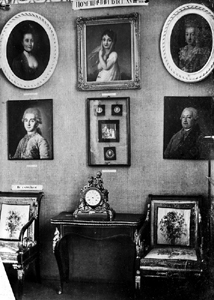
|
Fragments of the expositions of the Tver museum.
1910-1920s.
|
|
Fragments of the expositions of the Tver museum.
1910-1920s.
|
|
Fragments of the expositions of the Tver museum.
1910-1920s.
|
|
Fragments of the expositions of the Tver museum.
1910-1920s.
|
In 1931, when the city had been renamed, the museum changed its name to the Kalinin State Museum. The museum relocation in 1935 from the Tver Imperial palace building was a negative event in the pre-war life of the museum. In the context of the Kalinin region establishment, the building of the palace was transferred to the regional administration, and the Tver museum has been evicted into the buildings of three former churches located in different parts of the city and adapted to the needs of the museum operation. The museum funds were placed in the former Mina, Victor and Vincent church in Zatveretskaya part of the city and the former Resurrection church in Zatmatsaya part of the city. The central museum building was located at the city center, in the former Ascension church. While moving, the whole exposition of the museum, previously- housed in 17 halls of the palace, has been terminated, and the most interesting exhibits have gone to the store for long. From this moment, the museum exhibitions only partially used the richest: museum collections in accordance with the specified theme.
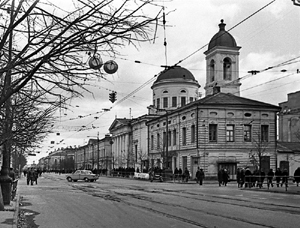
The Ascension church – the building of the museum in 1935-1958.
It was at that very period that the museum reorganization has stalled. In the context of Soviet ideology the museum was to carry out, above all, tasks of cultural and educational work, intensifying communist propaganda. In these years, new departments were created: historical-revolutionary, socialist construction; the manner of acquisition was also changed fundamentally. In those years, the inspectors of the Tver museum, while emphasized the richness of its collections, also pointed out its shortcomings:"... prior to the reorganization... the museum was a collection of rare and sometimes useless things compiled without purpose.”[3]
As far back as 1929, the Tver museum, which had a richest collection of Russian and Western European art, opened an art department. In 1937, on the basis of this department, the picture gallery was separated. It was established as an independent cultural institution and was a subordinate of the Regional Arts Department. The gallery was located in the same building as the museum (the Ascension church), occupying one third of its area. While separating the collections, the picture gallery acquired 1,500 items of paintings, sculptures, graphics, arts and crafts from the collections of the museum. For example, the monuments of church art, the icons, were divided into unique “masterpieces" and devotional articles; pictorial and graphic works, common core collections, suites of furniture, crockery, objects of artistic decoration were separated.
[4]
Before the war, the museum funds were divided into sections according to their character: nature, history, or socialist construction. Storage of museum items was organized systematically according to object type. The group of illustrative and supporting materials, such as prints, posters, drawings, and maps, was stored separately. By 1941, in the Tver museum there were 11 accession books and 3 inventory books. Quantitative estimation of the museum collection on the brink of the World War II was rather rough. Some documents report as much as 20,325 inventory items and collections, or 100,000 individual items together with the archaeological materials. In another preserved museum document of the pre-war time there is a rather short list of collections sorted by type and compiled by M.P.Petrova, Head of the museum fund, with a total of 19 to 20 thousand exhibits (with items such as painting or furniture obviously excluded from the list), with a note: “the figures are roughly estimated, for total inventory of the museum holdings was never done.”
[5] Aside from that, whole collections were being recorded in the museum accession books under a single number, which gives us an opportunity to presume that actually the quantity of items was larger.
When changing the museum board in 1939, the transfer acts show that the heads of major departments accepted custody of the main collections. The head of the historical department impounded the inventory list of historical-revolutionary department, items #1-2307 inclusive. Lists of nature department’s items, inventory book of historical department and lists of museum exhibits in the custody of M.P.Petrova, Head of the museum fund, inventory list #6, were also mentioned.[6] The latter was found in regional archive in the file mistakenly archived as “Lists of items located in the Kalinin Regional Museum funds for 1942.”
[7] The error was detected while working on a catalog of losses at more detailed study of the preserved museum. Inventory list # 6 comprises lists of the most valuable items from the pre-war museum collection, such as weapons, fabrics, numismatic collections, tableware, furniture, etc. The museum archives are also contains the “Lists of values of special storeroom”, its inspection acts when changing the directors of the museum before the war, denotes the number of the values as 423 storage units, as well as “A short list of unique museum exhibits” for 1935. Transaction documents for items that have been removed from the Kalinin Region Museum except for those transferred to the picture gallery have not been preserved or possibly not yet discovered.
In the museum accession book, there are records dated first months of the war. In July 1941, Russian orders and medals of Munters, former Foreign Minister of Latvia, total of 71 units, were recorded under number 20 671-20 727. This collection was found in the ruined the museum immediately after the occupation, but in July 1942 it will be transferred to Moscow as material evidence by sanction of a procurator.
[8]
With the outbreak of the war, in July 1941, by the Regional Executive Committee resolution, the picture gallery was transferred to Kalinin Regional Museum, staffing of the two institutions were reduced and funds, combined (in 1943, picture gallery will again become an independent institution). Packing the items from the museum storeroom into boxes has begun, but the substantive preparations for the shipment of museum values started only in early October. There was an instruction: “From October 8 begin packing paintings, as well as museum pieces packaging.”
[9] The evacuation was delayed due to lack of instructions from Narkompros concerning the destination place, although regional institutions including OBLONO were already evacuated to the city Kashin (the district center located on the North-East of the regional center).
The hassle of evacuation befell the new Director of the museum, В.I.Glazova, replacing V.A.Turkin who left for the front in July 1941. Glazova was sent to Moscow to solve the problems of evacuating. However, until October 13 she had not returned to the city, which was occupied by Nazi troops on October 14, 1941. Scientific secretary, acting Director of the museum, E.K.Mroz managed to leave for Kashin. Chief curator, M.P.Petrova died during the bombing of the city on the eve of the occupation. All museum treasures remained in the occupied city.
[10]
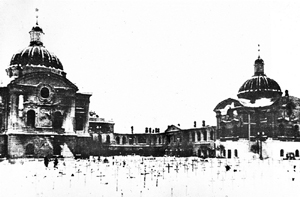
Building of the Tver Imperial palace. December 1941
Of the preserved museum documents we know that at this moment only museum silver was packed to evacuate. These were values of special storeroom, 7 boxes, where the inventory of 375 units was enclosed. They miraculously experienced occupation of the city despite the fact that the museum storage facility in the Resurrection church was raided and defeated. Premises of special storeroom with packed boxes were not opened.
[11]
Information on the events during two months of city occupation is rather stingy. In the building that housed the museum exposition and the picture gallery, the occupants restored the church. The exposition was in disarray: stands were disassembled. Part of the paintings and other property was stolen, exhibits piled together with the church subjects of non-museum values taken by the Germans to worship. Archives and library were also in complete disorder. The church, repository of the museum in Zatverechye, was burned down. During the retreat from the city, the occupants set fire to it. According to eyewitnesses, the residents of the city even before the fire plundered museum items from the churches. In the second repository, the building of the Resurrection church, windows were broken, roof damaged, museum objects were under a layer of snow.
[12] Scientific employee of the picture gallery, S.N.Yurenev, who remained in the city, tried to preserve the museum treasures, but he had, to some extent, to cooperate with the occupation authorities. After the liberation of the city, he was arrested and convicted (rehabilitated in the 1990s).
December 16, 1941, Kalinin was liberated. December 26, E.K.Mroz returned to the city. In her memoirs, there is the first information about the state of the ruined museum immediately after the liberation. Catching up on putting in order the museum building, the staff made the first attempts to compile a list of lost museum treasures. These lists are inaccurate and incomplete.
[13] Systematic work to identify losses of the museum began only with the arrival a new director.
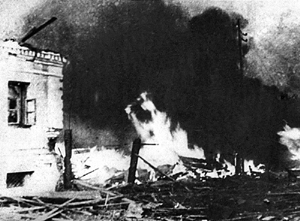
|
|
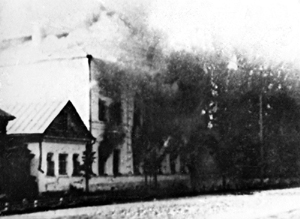
|
The Nazis set to buildings in the town before leaving
December 16, 1941
|
|
The Nazis set to buildings in the town before leaving
December 16, 1941
|
In February 1942, A.N.Topornin, which was sent from Moscow to Kalinin for the restoration of the museum, accepted the devastated the Kalinin Regional Museum for custody. Prior to this appointment, he worked at the People’s Commissariat of Education of the RSFSR as Deputy Chief of Museum and Local History department of the Office of the political educational work. He was familiar with the Tver museum collection, as he inspected it in 1928. It was necessary to put in order the ruined museum property, register the remaining items and museum collections, and open the museum for the public.
February 10, 1942 “to make an inventory reconciliation of the remnants of the museum property,” a commission was established consisting of three people: Director and research staff, E.K.Mroz and L.D.Predtechenskaya, who worked at the museum before the war as the head of the department of history. Employees disassembled the debris, compiled the necessary documentation, and made efforts to locate the stolen items. List of items of artistic and material value, stolen from the premises of the museum and funds during the occupation, was transferred to the Kalinin Militia Department.
[14] Only the list of lost economic assets of the museum was preserved.
At disassembling of burned-out storage facilities, the following items were removed from debris: 11 cannons, rush light holder, iron chandelier, tiles, burnt chain mail, household items made of metal. Prior to the occupation, in this store there were weapons, ceramics, wooden and metal utensils, fabrics, archaeological and zoological collections, and archival materials.
[15] There was no detailed inventory of this building’s assets before the occupation. Injured remnants of the museum property were transferred to the only museum storage facility at the Resurrection church. Analysis and registration of these items did not occur for a long time.
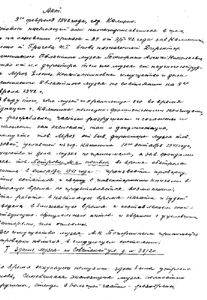
|
|
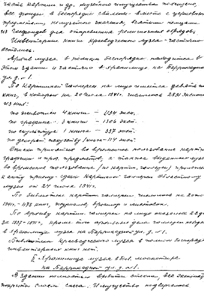
|
|
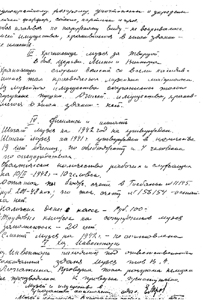
|
Report on the state of museum buildings and collections.
February 9, 1942.
|
|
Report on the state of museum buildings and collections.
February 9, 1942.
|
|
Report on the state of museum buildings and collections.
February 9, 1942.
|
Many items were removed from active collection records: dilapidated cloth, the church vestments affected by fire (12 items of the detected); the book belonging to the picture gallery, which were not found (116 items). Utensils of ceramics, earthenware, glass (39 units) considered economic assets as the objects of “not museum quality”. Some exhibits were transferred to the picture gallery (Act № 61, 1942). Simultaneously, museum objects were actively transferred for temporary storage to various city institutions, such as Courses for junior lieutenants of the Kalinin Front, evacuation hospital, OBLONO. Acts on write-off and removal of the artifacts from the collection for 1942 are not fully preserved, but the documentation says: “issued and excluded from the museum collections acts № 1-l5 without any records in the inventory books.”
[16] A.N.Topornin took over the management of the museum checking the presence of visually inspected items, without making a detailed reconciliation. The documents present information on completely remaining accession books of the Kalinin Regional Museum and the picture gallery. By the order of the director, double recording of picture gallery collections in the museum accession book from number 20 778 was carried out: “...new items of the Kalinin regional gallery should be recorded in accessory book of the picture gallery and in accessory book of museum...”
[17]
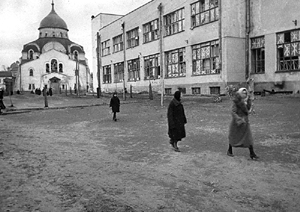
The Resurrection church – museum storage facility. April 1942
June 11, 1942 restored the Kalinin Regional Museum was opened to public. The exposition comprised the art department as the best- preserved part of the collection, and the exhibition “Kalinin region in the Great Patriotic War.” The Minister of Education of the RSFSR, V.P.Potemkin (a native of Tver land) declared to thank the scientific staff of the museum led by the director.
[18]
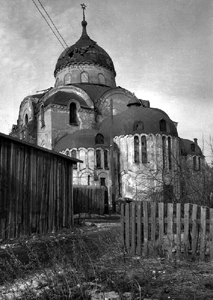
The Resurrection church – museum storage facility. 1966.
In spring 1942, the museum once again begins to prepare for evacuation. Today evacuation activities in the city liberated from the enemy cause perplexity. It can be assumed that they were related to the new expected attack of German-fascists troops on Moscow. In the surviving documents of the war years, we find only a reference to the instructions which the museum director received from OBLONO and special department of Narkompros concerning the implementation of special measures for the protection of museum collections and their evacuation to the rea.
[19]
The works on evacuation were carried out by the museum until mid-August 1942. The shipments of collections were divided into two stages; the first priority was shipping of the most valuable items from the preserved collections of picture gallery and museum. The museum property for the first stage of evacuation was packed into 24 boxes. The boxes numbered from 25 to 32 inclusive, contained collection of the picture gallery items.
The items of ready to evacuate museum collections, were diverse: in the boxes № 1-7, museum silver of special storeroom (this was exactly what has been prepared to evacuate in 1941 and survived the occupation); in the boxes № 8-24, fabrics of 18th - 19th centuries, weapons, artifacts of historical-revolutionary department, folders with archival documents. Essentially, these were the most valuable, but very scattered remnants of the richest collections of pre-war museum. On items listed in the packing acts (№ 1-17 for 1942), museum and inventory records were mostly present. The total number of packaged items and the museum collections for the first stage of evacuation amounted to 690 items (calculated by the acts). Property of picture gallery, packed for evacuation, was quantitatively estimated as 64 paintings and 517 graphic sheets (evacuation acts № 18-25 for 1942).
To evacuate the second stage of picture gallery, those items have been identified which in the overwhelming majority had minor meaning; for them 30 boxes were intended. “Almost nothing of the valuable museum pieces remains after shipping of the first stage”, wrote the museum director to OBLONO.
In the second stage (54 boxes) mainly scientific and subsidiary objects were packed: items of natural history, stuffed animals, geological and paleontological collections, herbaria, soil and excavation specimens, household metal, coins. In the museum acts on the second stage package, the accessory numbers were sometimes missing, the exact amount of collections not always specified. Rough estimate of the collection size gives the amount of 563 items.
[20] Thus, in 1942, the museum has prepared to evacuate approximately 1253 objects and collections, and it is virtually all that remained of the pre-war museum collection, outnumbering 22 thousand exhibits!
In early August 1942, A.N.Topornin reported OBLONO on shipping to the Kashin District Museum 32 boxes of particularly valuable preserved assets of the regional museum accompanied by Research assistant R.S.Taube. Re-evacuation of museum valuables would occur only in November 1944.
[21]
In August 1942, A.N.Topornin was recalled to Moscow. Until 1944, director of the museum was G.A.Kadysh, from April 1944, N.M.Uspenskiy.
In 1943, the Kalinin Regional Museum turned again to the calculation of damages and losses suffered during the occupation of the city. Scientists of the Kalinin Pedagogical Institute, associate professor M.F.Savina and prof. A.N.Vershinskiy, Head of the department of history who worked closely with the museum before the war, the author of 72 books on the history of the region, were involved in the compiling the act on damage. A.N.Vershinskiy actively participated in the survey of parts of the region liberated from the occupation, collecting the materials, as well as in the work of the regional commission on the assessment of material damage caused to the national economy of the area during the occupation. Compounded with his participation, the act of the damage suffered by the regional museum was the first document about losses. It was dated May 1943 and contained a list of lost museum collections compiled by type of items.[22]
All the archaeological collections obtained during excavations in 1860-1940 period, most of the ethnographic and numismatic collections, collection of ancient weapons of 15th - 19th centuries, collection of gold embroidery articles, etc. were reported missing. Not all kinds of specimens were quantified: the items of geological, paleontological, botanical collections as well as the collection of specimens of the stage of socialist construction were not counted. The most important thing in this document is the value of losses. Estimated amount of lost museum treasures, 5 897 904 rubles is shocking. Evacuation costs amounted to 1595 rubles. To this day, this final document remains the only one to assess the museum losses during the war. Rough estimation of the number of lost collections and items made by this report reveals the amount of 18,000 items. Approximately the same data were usually cited in the subsequent documents, including the records of the Emergency State Commission for Ascertaining and Investigating the Misdeeds of Nazi Invaders and their Accomplices and the Damage Done to Citizens, Kolkhozes, Civic Organizations, and Government Enterprises and Institutions of the USSR.
Devastated Kalinin museum has lost a huge part of its richest systematized collections, and from them have remained practically certain items.
It is hard to say today, how the report was drawn up, what members of the committee relied on. One can only assume that, apparently, on preserved accessory books, taking into account the residue of evacuated museum assets. In addition, A.N.Vershinskiy was perfectly familiar with the pre-war collection of the Kalinin museum. The amount of losses among the museum objects and collections, 18,000, unfortunately, was not made more precise. As in the war years, and in later times the lists of missing museum pieces were not compiled. The subsequent museum reports in 1943 and 1945, give very inaccurate information on the quantity, and individual missed exhibits. Thus, wartime museum documents provide information that during the occupation the relics of Vice-Admiral V.Kornilov, such as portrait, rear and vice-admiral's flags, the model of the tender “The Swan”, brig “Themistocles”, ship “12 Apostles”, and a saber of V.A.Kornilov had been destroyed. But as early as in 1879 they were transferred by Tver museum initially to the exhibition in Moscow, and later, to Sevastopol museum.
[23] In the published memoirs, museum workers named among the lost items the mosaic icon “Almighty Savior” manufactured by М.V.Lomonosov by request of Countess М.E.Shuvalova but in 1947 it was transferred by order from the Kalinin museum to Moscow. These inaccuracies are explained by the inventory of the museum prolonged for several years.
Moreover, at this time the museum maintains active exhibition, expedition, collecting work, especially over the period of the World War II. Thus, only in the first half 1944 the Kalinin Regional Museum collection was replenished by collection of Russian and foreign coins as well as coins of Tver principality, collection of fabrics of 19th - early 20th centuries in the number of 2573 specimens, and 900 items of auxiliary materials on military issues.
In the summer of 1944 the museum began an inventory of assets. In this work, along with staff, the students the Kalinin Pedagogical Institute took part. None of the museum staff that started the inventory worked at the museum before the war and knew thoroughly the museum collection. Checking and recording of exhibits occurred with long intervals, and only in summer time, as the fund premises did not have room heating. Items from preserved collections and new acquisitions for the years 1945-1953 were recorded in the inventory books of Kalinin Regional Museum. Only in 1947, re-evacuated property is recorded in these books, above all, values of the special storeroom in the amount of 360 units.
[24]
In two new inventory books were originally recorded register entries, that allows revealing the assets of the old museum, but at the end of the inventory book, the specimens of the old museum (recognizable by pre-war lists of museum collections) were obviously recorded without the previous numbers in the amount of 119 items. Recording the remnants of collections continued until 1952; the data on the balance of valuable museum items were intermediate: “On 08/25/1944, after the inventory of the museum has together with re-evacuated specimens 836 exhibits”. In 1945, another data are cited, namely 1560 inventory entries. Fixed to 1952 in two inventory books, the residue of the collections of pre-war museum was about 2039 items, and this amount did not include documentary and photographic collections.
[25]
In the early postwar years, the premises were still a big problem for the museum, its funds suffered in the war are gradually increased due to new revenues, and by 1947 they comprised 14 thousand units, a library of 4555 books, archives of 1243 items.
[26] But overall, war years caused the huge irreparable loss to the regional museum.
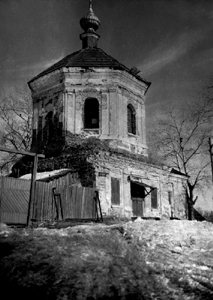
The Mina, Victor and Vincent church – museum storage facility. 1950s.
Later the museum almost did not take any action on the calculation of losses and search for museum items. Only today, thanks to the fact that the work on compiling of the Summary Catalogue of cultural values of the Russian Federation stolen and lost in the Second World War, has started, we can make an attempt to name item-by-item the richest collections of Tver museum lost during the war. Unfortunately, in the war years and nowadays, only the approximate amount of museum items of Kalinin museum before the war was known. Also the fate of museum values disappeared from its collections during the occupation of the city is still obscure. One can only assume that not evacuated museum values either were killed by fire, or were plundered by invaders. For example, A.Shirokorad in the book “Secrets of the Russian artillery” wrote that during the occupation of Kalinin, the German soldiers stole the mortars, the earliest specimen of Russian arms, from Kalinin museum. Unfortunately, he does not give the reference to the source of the information. In addition, as evidence by witnesses, the local inhabitants also plundered museum objects from the ruined and abandoned to their fate museum buildings. In general, the destruction and disappearance of a huge number of the cultural values from the richest: Tver museum can be attributed to a destructive war, which brought our country irreparable disaster, human and material loss.
V.V.Glafirova
[1] Protocols and Reports of the 1st Provincial Congress for museums and preservation of antiquities, art and nature. July 15-21, 1921 // the Tver State United Museum (TGOM). P-1. Oп. 1. Д. 26. 1.63.
[2] The Tver State Museum report on the transfer of museum documents to Gubarhivbyuro. July 2, 1928. Report on the transfer of manuscripts from the Kalinin Regional Museum to the Regional Archive Department. March 1935. Abstract of Vazhanov's report on the state of the Tver museum library // State Archives of the Tver region (GATO). Ф. P - 56.Оп. 1.Д. 118,Д. 50. Л. 75.
[3] Certificate of inspection of the Tver State Museum by Glavnauka representatives. 1928 //Ibid. Д. 53. Л. 50.
[4] Gershfeld B. The history of foundation of the Tver Regional Picture Gallery // Вестник TOКГ [TOKG HeraldJ. 2007. № 5-7
[5] Reference data on the Kalinin Regional Museum. 1942. Information about the Kalinin Regional Museum funds. Not earlier than 1939 // TGOM. P-l. Oп. 1. Д. 82. Л. 26-27. Д. 212. Л. 48.
[6] Report on the transfer of museum property and documentation at changing the museum board on June 27, 1939 //TGOM. Ф. P-56. Оп. 1. Д. 170. Л. 2.
[7] Lists of items located in the museum funds. 1942 // GATO. Ф. P-56. Оп. 1. Д. 212.
[8] Report №65 dated May 1, 1942 // TGOM.Р-1. Оп. 1. Д. 79. Л. 52. From the letter to the director of the Kalinin Regional Museum from the investigator at the USSR Prosecutor’s Office: “…urgently send me to Moscow … orders and medals of former Latvian Foreign Minister Munters, which are material evidence of the case” // GATO. Ф. Р-56ю Оп. 1. Д. 210. Л. 43.
[9] Packing reports on items of museum special storeroom dated July 8-9, 1941: Orders of the Kalinin Regional Museum for 1938-1942 // TGOM. Р-1. Оп. 1. Д. 77. Л. 2-4. Д. 65.
[10] Information of the Regional Department of Public Education “On the OBLONO evacuation" dated October 13-18, 1941 // The Tver Documentation Center of Contemporary History (TTsDNI). Ф. 147. Оп. 3. Д 81. Л. 31.
[11] Act № 1 of the Kalinin Regional Museum dated August 30, 1942 // GATO. Ф. P-56. Оп. 1. Д. 206.
[12] Act of taking property and affairs of the Kalinin Regional Museum dated February 9, 1942 // GATO. Ф. P-56. Оп. 1. Д. 209. Л. 8-9.
[13] Mroz E.K. From the history of the picture gallery collection. 1940s. Scientific archives of the Tver Regional Picture Gallery. Collection of manuscripts by E.K.Mroz, №16. Orders of the Kalinin Regional Museum. 1942 // TGOM. P-1. Оп. 1.Д. 79. Л. 33-36, 38-41,64-65.
[14] The letter of the Director of museum A.N.Topornin to the Chief of Kalinin Militia Department dated January 27, 1942 //TGOM. P-l.Оп. 1.Д. 79. Л.63.
[15] Act of the Kalinin Regional Museum for the damage caused to the museum and the state of storage facilities over Tvertsa. March 1, 1942 // GATO. Ф. P-56. Оп. 1. Д. 208. Л. 5.
[16] Acts of the issuance of the Tver Regional Museum. 1942 // GATO. Д. 210. Л. 39-41; ТГОМ. P- 1. Оп. 1. Д. 80. Л. 10 об. Д. 82.
[17] Order №29 of the Kalinin Regional Museum. 1942 // TGOM. Р-1. Оп. 1. Д. 78.
[18] Order №65 of the Kalinin Regional Museum dated August 1, 1942 // Ibid.
[19] Memorandum of the Director of museum A.N.Topornin to the Head of Kalinin OBLONO P.G.Grachev dated August 6, 1942 // GATO. Ф.Р-56. Оп.1. Д.206. Л.39, 39 об. Ibid. Acts on the packaging in boxes. July 30 – August 5, 1942 // GATO. Ф.Р-56.Оп.1. Д.206. Л. 1-18. Acts on the packaging of the museum collection: the 2nd stage // TGOM.Р-1.Оп.1.Д.79.
[20] Notification for the Kalinin Regional Department on Cultural-Educational Work. April 16, 1945 // TGOM.Р-1.Оп.1.Д.82.Л.41 об.
[21] Act of damage and losses caused by German fascist invaders. May 17, 1943 //GATO. Ф. P-56. Оп. 1. Д. 208.
[22] Reports of the Kalinin Regional Museum for 1943. Information about the Kalinin Regional Museum. May 16, 1945 // TGOM. P-1. Оп. 1. Д. 82. Л. 31; 40-41..
[23] Letter of Head of the museum fund M.P.Petrova to the Museum of Sevastopol Defense. January 2, 1941 // GATO. Ф. P-56. Оп. 1. Д. 200. Л. 49
[24] Information about the Kalinin Regional Museum. May 16, 1945 // TGOM. P-1. Оп. 1. Д. 82. Л. 31. Inventory book of Kalinin Regional Museum on the items of preserved collections. Part 1-2. 1945-1953 // TGOM. P-l. Оп. 1. Д.90. Д. 91. Reports of Kalinin Regional Museum for 1945 // Ibid. Д. 82. Л. 45.
[25] Reports of the Kalinin Regional Museum for 1946, 1949 // TGOM. P-1. Оп. 1. Д. 82. Л. 55; Д. 80. Л. 14. Author’s calculation.
[26] Shirokorad A. Secrets of the Russian artillery. Moscow, Yauza, publisher EXМО [Яуза, ЭКСМО], 2003. P 16.
Explanatory notes for the Catalogue
The descriptions of museum objects and collections are compiled by the records in accession books (AB) of the Tver museum, from AB # 1 (1871). Often several items or a collection are recorded under the same number in AB, such as costumes on mannequins. In the Catalogue, the amount is not specified in the case when one item is recorded.
Mixed classification items and collections in the Catalogue persist in subsequent books. To allocate each part of the Catalogue as a separate volume is not possible due to the large volume of data (11 accession books are preserved, which recorded more than 20,000 items).
In AB, descriptions of objects and collections are incomplete, difficult to read and understand, so in some cases the descriptions were cited by AB. Often the description lacks dating, dimensions, materials, preservation. In this case, they just are not specified in the Catalogue. The compilers felt it necessary to save in the descriptions provenance data, which allows an approximate dating of the specimen.
When descriptions were edited, all the features of items and collections from AB were maintained; the size was transferred into a modern system of measurement.
At the end of each description, the number of an item or collection is indicated in the Catalogue according to AB of the Tver museum.
Some items of numismatic collection cannot be identified by the records in AB due to insufficient information. In particular, this applies to group accounts. In addition, they were have been decertified when preparing for evacuation, when they were listed by parcels, packages, cans, mugs, without any description or indication the weight and quantity. For these reasons, a number of numismatic items received and described before the war are not included in the Catalogue.
The fragments of museum objects, which cannot be identified, are also not included.
In the Catalogue, images of lost items are presented at the pre-war photos depicting the fragments of Tver museum exhibitions, drawings from the book “Description of the Tver Museum,” published in Moscow in 1888, as well as the photos taken from similar objects.
Abbreviations
AB - accession book.
GATO [ГАТО] - the State Archives of the Tver region.
Glavnauka [Главнаука] - the Central Administration for Scientific, Scholarly-Artistic, and Museum Institutions of Narkompros.
Gubarhivbyuro [Губархивбюро] - the Archives Bureau of province.
MF - museum fund.
Narkompros [Наркомпрос] - the People’s Commissariat for Education.
OBLONO [ОблОНО] - the Regional Department of Public Education.
TGOM [ТГОМ] - the Tver State United Museum.
TOKG [ТОКГ] - the Tver Regional Picture Gallery.
TTsDNI [ТЦДНИ] - the Tver Documentation Center of Contemporary History.
TUAC [ТУАК] - the Tver Scientific Archive Commission.
Ф., Об., Oп., Д., Л. - terms used for describing archival records in Russia.
|




